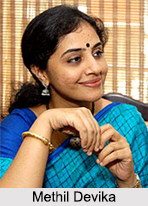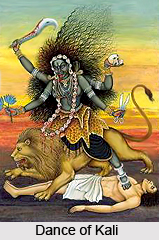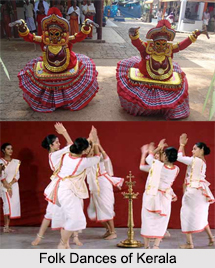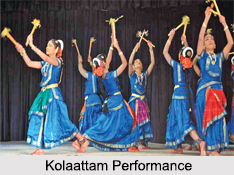The coastal region in the west, extending from Goa to the border of Malabar has been divided into two parts, according to the differences in the technique of portrayal of Yakshagana. The Yakshagana of the northern region is called the Badagu tittu while that of the southern region is known as Tenku tittu. Udipi is the demarcating taluka. The Bhagavata of Badagu tittu uses a pair of cymbals (tala) while his counterpart in Tenku tittu uses the Gong (Jugate Kolu); the Mridanga of the North is longer and narrower at the ends giving sharp notes at a high pitch while in the South, the Mridanga has a greater diameter, giving the base notes of Kala and Mandara with sounds of Jhankar and Dhinkar; Chande in the south is used with better proficiency as an accompaniment for rousing even a delicate sentiment like Srngara and subtle dances as lasya and the reason for this superior exploitation of this powerful percussion instrument in the south is perhaps due to the better efficiency of the southerners in making this instrument. While the performance in the North pays greater attention to acting (abhinaya), the southern style has specialised in the art and technique of dancing. The Bhagavata of Tenku tittu is a lone singer, while in the north the Bhagavata is invariably accompanied by the performing artist also. While the northern Bhagavata stops singing with the beating of the cymbal, in the south, the Gong (Jagate Kolu) continues in three rounds even after the recitation of the Bhagavata stops, in order to give finesse to the dance of the character.
Finally, the make-up and costumes of the southern style is better in details and more imposing owing to the influence of the methods of Kathakali. These differences in the performances of Badagu tittu and Tenku tittu are obviously due to the local and regional influences as well as contacts; but the source and purpose of the performances remain the same and they produce almost the same unity of impression.
Prasanga Yakshagana is an open air play, and it cannot be performed during the monsoons, when, for four months in the year, heavy rains drench the coastal belt. In the absence of a full dress performance of Yakshagana in the open air, the coastal region has evolved an alternative method in what is called Prasanga or Tola Maddale, an indoor entertainment, closely following the methods laid down by Yakshagana. Prasanga is a virtual Yakshagana performance without the latter`s make-up, costumes and dances. In the presence of an audience assembled in a spacious hall, the Bhagavata sits in the centre with his accompaniments, and the artists (Arthadharias they are called in contrast with Vesadhari of Yakshagana) sit in front of him in two rows, each opposite to the other. The Bhagavata selects a particular Prasanga, sings the invocation and recites verses as in Yakshagana. The verses are interpreted by the artists each of whom assumes a role in the play, though he is not made up, nor costumed for it. Still, the illusion is created, for the participants talk with all the vigour, bearing and understanding of the roles they portray. The individual entity of the participant recedes into the background and the mythological heroes rise up before the mental eye and the audience enjoy the performance immensely, for after all, the physical eye beholds much less than the mental.
The Prasanga concentrates on the literary and emotional exposition of a theme. Compositions like Krishna Sandhana and Angada Sandhana, which provide greater scope for literary exposition and imaginative interpretation, are usually selected. The Prasanga is an evidence to show that tense dramatic situations and atmosphere could be created without dance or even costumes. What the Pauranik, the Kirtanakara and the Pathaka did single handed is done more ably by a team of learned artists here. The Prasanga has more dramatic tension in it than the performance of the Puranika or Kirtanakara; but still, it cannot be a Nataka in the correct sense of the word because of the absence of settings, dance, make-up and costumes. It is not improbable however, that it is the middle step between the pravachanakara on the one hand and the full-fledged Yaksanataka on the other in the evolution of the Kannada theatre.




